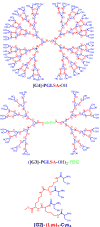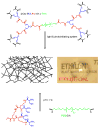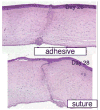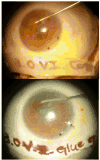Designing hydrogel adhesives for corneal wound repair
- PMID: 17889330
- PMCID: PMC3878817
- DOI: 10.1016/j.biomaterials.2007.08.041
Designing hydrogel adhesives for corneal wound repair
Abstract
Today, corneal wounds are repaired using nylon sutures. Yet there are a number of complications associated with suturing the cornea, and thus there is interest in an adhesive to replace or supplement sutures in the repair of corneal wounds. We are designing and evaluating corneal adhesives prepared from dendrimers--single molecular weight and highly branched polymers. We have explored two strategies to form these ocular adhesives. The first involves a photocrosslinking reaction and the second uses a peptide ligation reaction to couple the individual dendrimers together to form the adhesive. These adhesives were successfully used to repair corneal perforations, close the flap produced in a LASIK procedure, and secure a corneal transplant.
Figures


 portion for coupling to a growing dendrimer, a
portion for coupling to a growing dendrimer, a
 portion which has two potential coupling sites which is capped by a
portion which has two potential coupling sites which is capped by a
 protecting group. After the monomer is coupled, the protecting group is removed, and the monomer is added again to create the large dendrimer. This process is repeated until a specific dendrimer generation is prepared.
protecting group. After the monomer is coupled, the protecting group is removed, and the monomer is added again to create the large dendrimer. This process is repeated until a specific dendrimer generation is prepared.
 ) dendrimer ([G4]-P
) dendrimer ([G4]-P
 -OH), a generation 3 dendritic-linear copolymer (([G3]-P
-OH), a generation 3 dendritic-linear copolymer (([G3]-P
 -OH)2-
-OH)2-
 ), and a generation 2 lysine-cysteine dendron ([G2]-
), and a generation 2 lysine-cysteine dendron ([G2]-
 ).
).




 and
and
 -DA.
-DA.References
-
- Nirankari VS, Karesh JW, Richards RD. Complications of exposed monofilament sutures. Am J Ophthalmol. 1983;95:515–519. - PubMed
-
- Shahinian LJ, Brown SI. Postoperative complications with protruding monofilament nylon sutures. Am J Ophthalmol. 1977;83:546–548. - PubMed
-
- Varley GA, Meisler DM. Complications of penetrating keratoplasty: Graft infections. Refract Corneal Surg. 1991;7:62–66. - PubMed
-
- Binder PS. Selective suture removal can reduce postkeratoplasty astigmatism. Ophthalmology. 1985;92:1412–1416. - PubMed
-
- Webster RG, Slansky HH, Refojo MM, Boruchoff SA, Dohlman CH. The use of adhesive for the closure of corneal perforations. Arch Ophthalmol. 1968;80:705–709. - PubMed
Publication types
MeSH terms
Substances
Grants and funding
LinkOut - more resources
Full Text Sources
Other Literature Sources
Medical

